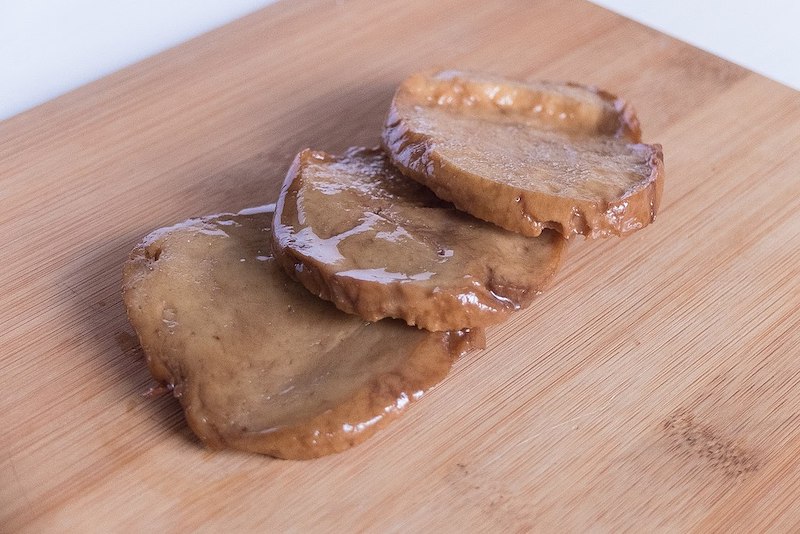Help! Why Is My Seitan Rubbery?
For people new to cooking and eating seitan, you might notice some interesting things about its texture.
One common question is – why is my seitan rubbery? When it isn’t prepared properly, the texture can be spongy or, worse yet, rubbery, which usually happens when it’s kneaded too much.
For everyone who needs help with rubbery seitan, this guide will cover everything you need to know to get perfectly textured seitan.
What Consistency Should Seitan Be?
When it is first mixed, seitan is essentially a stiff dough and can have a wide range of textures and consistencies.
Depending on how it is cooked and handled, seitan can have a chewy, meaty texture like chicken or mushrooms; have a soft, spongy texture like tofu, or have a rubbery, elastic texture like… well, rubber.
There are several factors that influence the consistency of seitan, and, once you have mastered the techniques, you can control the texture of your seitan so it has the bite and mouthfeel you find most satisfying.
What Makes Seitan Rubbery?
When making seitan, the process of mixing and kneading the dough develops the gluten and determines the final texture.
Seitan is formed with the proteins in wheat, called gluten. When the natural proteins in wheat are exposed to water, these proteins combine and form strong, stretchy bonds.
The process of mixing, kneading, and working a wheat dough ensures that these proteins combine with the water and encourages the formation and strength of these bonds into a web-like structure.
The process of deliberately physically kneading and manipulating these bonds is called “activating” the gluten.
Gluten is extremely stretchy and elastic.
In bread and pastry, gluten creates structure and a chewy texture, but it can also make dough so elastic that it is difficult to roll out, and simply contracts back to the original shape.
For people who use wheat flours in baking, mastering the properties of gluten to impart structure and texture without becoming dense and rubbery is essential.
Many of those same bread-making techniques are necessary when making seitan.
Seitan gets rubbery when it is kneaded too much. Knead it even more and it becomes spongy. Knead it too little and it is soft and doughy.
The perfect seitan consistency is achieved by mixing and kneading it just the right amount.
How To Make Seitan Less Rubbery
The more gluten is mixed and kneaded, the more elastic and rubberier it becomes. However, allowing it to rest after mixing and kneading allows the gluten to relax and soften
For perfect, chewy, meaty seitan, follow these steps:
Step 1: Mix Your Seitan Gently
Many people use a stand mixer to combine the ingredients to make seitan. Mixing develops gluten and texture in the seitan, but can also make it rubbery.
Mix the ingredients completely but gently, so that you can control the gluten development in the subsequent steps.
Step 2: Knead the Seitan
After mixing to combine, knead the seitan for 3-5 minutes. As you knead, you will feel or see the seitan transition from a sticky mixture to a smooth, firm dough.
When you stretch the dough, it will contract back into shape; that is the gluten developing and creating texture.
Knead until you have an elastic texture but don’t knead too much: if the dough snaps back into shape and can’t easily be stretched out, it has become rubbery.
Step 3: Rest the Dough
After kneading, set the dough aside in a cool place to relax for 10-15 minutes. Just like when making bread, resting your seitan allows the gluten to relax and reduces the rubbery elasticity.
Step 4: Knead it Again
After the dough has rested, knead it for just another 1-2 minutes, or as needed for your recipe.
Tips for Making Seitan Less Rubbery
Following the above steps will give you the most control over the texture and consistency of your seitan.
Mixing gently does not prematurely activate the gluten, so you can develop just as much structure as necessary when you knead.
Kneading forms and activates the gluten, so you have structure and texture in your finished dish. Resting the dough allows the gluten fibers to relax, so they aren’t as elastic and rubbery.
Then a quick final knead allows you to impart the right consistency for the dish you are preparing. This will give you seitan that is firm and chewy, without being tough or rubbery.
The best way to make the perfect seitan and eliminate that unpleasant rubbery texture forever is to practice.
As you work with the process of kneading and resting, you will better understand how to control the gluten in your seitan, so you can choose what texture you want to create.
If you over mix or over knead and make it rubbery, simply rest the dough in a cool place before proceeding, so that the gluten fibers relax and expand.
If your seitan is soft and gummy, knead it for longer to activate more gluten and give it more structure.
In Summary
Making seitan is a lot like making bread.
Bread makers practice extensively to activate gluten to create just the right amount of structure and texture, without making bread too dense and chewy.
Likewise, seitan can be worked with to create the perfect texture. With practice, you can create the perfect texture in your seitan, and never have rubbery seitan again.







